|
|
 |
|
Calanoida ( Order ) |
|
|
|
Arietelloidea ( Superfamily ) |
|
|
|
Arietellidae ( Family ) |
|
|
|
Paraugaptilus ( Genus ) |
|
|
| |
Paraugaptilus buchani Wolfenden, 1904 (F,M) | |
| | | | | | | Syn.: | no Arietellus buchani : Sars, 1907 a (p.26);
no Paraugaptilus buchani : Sars, 1925 (p.336, figs.F,M); Rose, 1933 a (p.242, figs.F,M); C.B. Wilson, 1950 (p.275, fig.F); Brodsky, 1950 (1967) (part., p.398, figs.F,M); Vives & Shmeleva, 2007 (p.166, figs.F,M, Rem.);
? P. buchani : Bradford, 1974 a (p.524, fig.M, Rem.); Bradford-Grieve, 1999 b (p.39, figs.M) | | | | Ref.: | | | Wolfenden, 1904 (p.123, figs.F, Descr.F); Van Breemen, 1908 a (p.138, figs.F, Rem.); Farran, 1908 b (p.82); Wolfenden, 1911 (p.353, 354, figs.F, Rem.); Esterly, 1911 (p.335, figs.F, Rem.); Lysholm & al., 1945 (p.40); Tanaka, 1964 c (p.234, figs.F juv., Rem.); Vervoort, 1965 (p.155, Rem.); Brodsky, 1950 (1967) (p.398, figs.F,M, Rem.); Deevey, 1973 (p.254, figs.F,M, Rem.); Ohtsuka & al., 1994 (p.147, Rem.F,M, figs.F,M); Chihara & Murano, 1997 (p.721, Pl.: 52: F,M); Bradford-Grieve & al., 1999 (p.882, 937, figs.F,M); Blanco-Bercial & al., 2011 (p.103, Table 1, Biol. mol, phylogeny) | 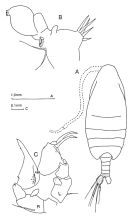 issued from : J.M. Bradford-Grieve in The Marine Fauna of New Zealand: Pelagic Calanoid Copepoda. National Institute of Water and Atmospheric Research (NIWA). NIWA Biodiversity Memoir, 111, 1999. [p.39, Fig.14]. Male: A, habius (dorsal); B, Mx1; C, P5. Nota: According to the author this male specimen may prove to be an undescribed species (compared with Deevey, 1973).
|
 issued from : S. Ohtsuka, G.A. Boxshall & H.S.J. Roe in Bull. nat. Hist. Lond. (Zool.), 1994, 60 (2). [p.151, Fig.32]. Female: A, A1 (segments XXII to XXVIII); B, Md (mandibular exopod); C, praecoxal arthrite and coxal endite of Mx1; D, 4th to 6th endopod segments of Mxp (innermost seta on 4th and 5th segments indicated by arrowheads); E, 6th endopod segment of Mxp. Nota: Cephalosome separate from 1st pedigerous somite. Genital double-somite similar to that of P. similis, but relatively shorter, left copulatory pore located near posterior margin . Left A1 with same fusion pattern and armature as in female P. similis except for segment XXIII incompletely fused with segments XXIV-XXV; segments XXV and XXVI incompletely fused; left compound segment XXVI-XXVIII with 7 setae and aesthetasc. A2: 2nd endopodal segment about 1.9 times as long as 1st, with 1 minute inner seta at mid-length and 5 setae and 1 vestigial seta terminally, as in P. similis; exopod similar in segmentation and setation to that of P. similis. Mandibular palp: 1st exopodal segment with vestigial seta as in P. similis. Mxp: 6th endopodal segment similar to that of P. similis, but seta c with terminal spinules incompletely fused to seta. Male: F, A1 (segments XIX to XXVIII); G, Md (mandibular exopod); H, 2nd exopod segment of right P5; I, inner medial process on 2nd exopod segment of right P5; J, outer margin of 2nd exopod segment of right P5. Scales in mm. Nota: P5, both coxae and intercoxal sclerite completely fused; coxa and basis separate in left leg and incompletely fused in right (almost completely fused on posterior surface); both endopods 1-segmented, lobate; right exopod with 2nd and 3rd segments almost completely fused to form lamelliform compound segment, tapering distally; inner medial triangular process with 2 minute spinules at tip; 1 subterminal outer and 1 terminal setule present, muscles between 2nd and 3rd segments present, but less developed than in Paraugaptiloides; left exopod similar to that of male P. similis. Left A1 with same fusion pattern and armature as in P. similis except for seta on segment XXII not modified into process; process on segment XXIV-XXV not so developed as in male P. similis, not reaching beyond end of antennule, directed straight forwards. A2 similar in segmentation and setation to that of female; 2nd endoipodal segment about 1.4 times as long as 1st. Md: mandibular palp 1st exopodal segment with well-developed seta. Mx1 praecoxal arthrite with 5 spines; tubular gland opening on inner surface.
|
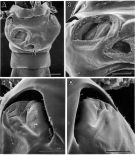 issued from : S. Ohtsuka, G.A. Boxshall & H.S.J. Roe in Bull. nat. Hist. Lond. (Zool.), 1994, 60 (2). [p.150, Fig.31]. Female (SEM micrographs): A, genital double-somite (copulatory pores arrowed); B, copulatory pores; C, right gonopore; D, left gonopore. Scale bars: 0.100 mm (A); 0.050 mm (B); 0.020 mm (C-D). Nota: genital double-somite similar to that of P. similis, but relatively shorter, left copulatory pore located near posterior margin.
|
 issued from : G.B. Deevey in Proc.Biol. Soc. Wash., 1973, 86 (21). [p.255, Fig.4]. Female: a-b, habitus (dorsal and lateral, respectively); c, A1; d, Md; e, another view of Md blade; f, Mx1; g, P5; h, P5 (lateral view); i, genital segment (lateral view). Nota : Head about ½ cephalothorax length, weakly fused with 1st pedigerous segment. last thoracic segment with blunt tooth dorsally on each side. Urosome 30% or less of cephalothorax length. Genital segment very slightly asymmetrical in dorsal view, dilated ventrally, developed asymmetrically ventrally on the left side. Caudal rami less than half as long as wide ; with fine hairs laterally ; caudal setae subequal, 2nd and 3rd inner setae jointed near base, finely plumose, short bent dorsal seta visible in lateral view. A1 21-segmented, 20th and 21st segments partially fused, reaching to genital segment. Exopodite of A2 42-43% length of endopodite ; enropodite with tiny seta midlength of distal segment. Md, Mx1, Mx2 and Mxp similar to those of P. bermudensis. Endopod of P1 clearly segmented. P5 with a finely plumose lateral and apical seta, sometimes a tiny blunt spinule beside apical seta. Male: j, P1; k, P2; l, P4. Scale at bottom right for a-c; on right margin for d-j. Scales in mm. Male : Head about ½ cephalothorax length, weakly fused with 1st pedigerous segment. last thoracic segment with a blunt tooth dorsally on each side, more prominent on right side yjan on left. Urosome 30% or less of cephalothorax length. Caudal rami less than twice as long as wide, with fine hairs on lateral margins ; caudal setae finely plumose, 2nd inner seta much longer than the others. Right A1 21-segmented, 20th and 21st segments partially fused. Left A1 geniculate, 20-segmented, 19th and 20th segments partially fused, jointed between 17th and 18th segments. A2 similar to female’s, exopodite 46% of endopodite length ; endopodite with tiny seta midlength of last segment. Md as in P. bermudensis, with extra seta near base of last palp segment. Mx1, Mx2 and Mxp as in female. P1 to P4 similar to female’s. P5 : last segment of left leg with a strong pincerlike spine and a shorter, curved process, bifid at the tip. This process is also bifid in P. similis males (Scott, 1909, Pl. XLII, fig.19). Roe’s (1972) male specimen of P. buchani has P5 similar to those here described, except that the small proximal spine on the last segment of the left is missing. As previously noted, a single male specimen with different P5 was caught in the 500-1000 m tow. In the proportions of the body, the length of the caudal rami and structure of the appendages, this specimen is similar to the P. buchani male. P5 are also similar in structure, except that the two pincerlike spines on the last segment of the left leg are laxking and replaced by two short spinules (probably malformation).
|
 issued from : G.B. Deevey in Proc.Biol. Soc. Wash., 1973, 86 (21). [p.253, Fig.3, l]. genital segment (ventral view). Scale in mm.
|
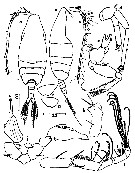 issued from : G.B. Deevey in Proc.Biol. Soc. Wash., 1973, 86 (21). [p.256, Fig.5]. Male: a-b, habitus (dorsal and lateral, respectively); c, right A1; d, A2; e, Md; f, left side of last thoracic segment; g, right side of last thoracic segment; h, inner side of 1st segment ogf Mxp; i, Mxp; j, P5. Scale at left for a-c; lower center for d-j. Scales in mm. Nota: Right A1 at least as long as cephalothorax.
|
 issued from : C.O. Esterly in Univ. Calif. Publs Zool., 1911, 6 (14). [Pl.26, Fig.6]. Female (from San Diego Region): 6, habitus (lateral).
|
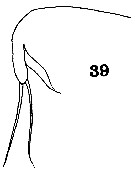 issued from : C.O. Esterly in Univ. Calif. Publs Zool., 1911, 6 (14). [Pl.28, Fig.39]. Female: 39, forehead (lateral).
|
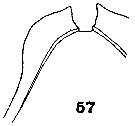 issued from : C.O. Esterly in Univ. Calif. Publs Zool., 1911, 6 (14). [Pl.29, Fig.57]. Female: 57, forehead with rostrum from below.
|
 issued from : C.O. Esterly in Univ. Calif. Publs Zool., 1911, 6 (14). [Pl.3, Figs.94, 98]. Female: P5; 98, distal segments of A1.
|
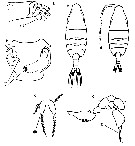 Issued from : M. Chihara & M. Murano in An Illustrated Guide to Marine Plankton in Japan, 1997. [p.723, Pl. 52, fig.64 a-f]. After Ohtsuka & al., 1994 (a, b), and Deevey, 1973 (c-f) Female: a, terminal setae on the distal exopodal segments of A2; b, genital segment (ventral); c, P5; e, habitus (dorsal). Male: d, P5; f, habitus (dorsal). Nota: Numbers show species characters.
|
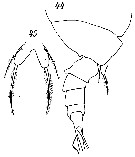 Issued from : R.N. Wolfenden in J. mar. biol. Ass. U.K., n. ser., VII, 1904. [Pl. IX, figs.44, 45]. Female (from 59°18'-59°54'N, 8°80'-8°42'W): 44, last thoracic segment with P5 and abdomen (lateral); 45, P5. Nota : Head very much narrowed in front and general shape like in Augaptilus. Rostrum with 2 slender filaments, very divergent. Abdomen 4-segmented. Genital segment very protuberant ventrally and twice as long as the next, which with the middle and anal segment are each of the same size. Caudal rami not quite twice as long as broad, each with 4 setae (the longest about as long as the abdomen) and a short dorsal accessory bristle. Last thoracic segment on each side dorsally ends in a short stumpy spine. A1 21-segmented, 1st and 2nd segments comparatively long, 9th very short and compressed, 11th partly divided from the 12th, the 12th from the 13th ; left A1 a little longer than the right, neither of them as long as the whole body. Endopodite of A2 about twice as long as the exopodite ; Md one-branhed only ; masticatory plate like Arietellus. Mx1 with the inner lobes much reduced, 2nd basal and endopodite fuseds with only 3 distal bristles, 1st inner lobes with 5, and exopodite short with 2 bristles Mx2 very like that of Arietellus divided into 3 segments, the first two with small lobes and short bristles, endopodite short and with very long bristles (8) provided with augaptiloid cups. Mxp with endopodite as long as the 2nd basal segment, its segments, 5 in number, progressively diminishing in size, the first two large ; many of its bristles have the augaptiloid cups. P1 to P4 with endopodites and exopodites 3-segmented each. P5 consisting only of a foliaceous plate on each side, imperfectly segmented into two, and carrying each 1 long marginal and 1 longer apical bristle.
|
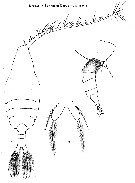 Issued from : R.N. Wolfenden in Dt. Südpol.-Exped., 1911, 12 (= Zool. 4). [Taf. XXXIX, figs. 5-7]. Female: 5, habitus (dorsal); 6, last thoracic segment with P5 and urosome (lateral); 7, P5.
| | | | | Compl. Ref.: | | | Sewell, 1948 (p.505, 559, 564, 569); Itoh, 1970 (tab.1); Roe, 1972 (p.277, tabl.1, tabl.2); Deevey & Brooks, 1977 (p.156, tab.2, Station "S"); Stephen & Rao, 1980 (p.239, tab.1, 2, fig.1); Vives, 1982 (p.294); Guangshan & Honglin, 1984 (p.118, tab., Rem.: p.165); Madhupratap & Haridas, 1986 (p.105, tab.1); Lozano Soldevilla & al., 1988 (p.60); Hattori, 1991 (tab.1, Appendix); Shih & Young, 1995 (p.67); Suarez-Morales & Gasca, 1998 a (p108); Holmes, 2001 (p.14); Schnack-Schiel & al., 2010 (p.2064, Table 2: E Atlantic subtropical/tropical); in CalCOFI regional list (MDO, Nov. 2013; M. Ohman, comm. pers.) | | | | NZ: | 10 + 3 doubtful | | |
|
Distribution map of Paraugaptilus buchani by geographical zones
|
| | | | | | | | |  issued from : R. Stephen & T.S.S. Rao in J. Plankton Res., 1980, 2 (2). [p.242, Fig.1]. issued from : R. Stephen & T.S.S. Rao in J. Plankton Res., 1980, 2 (2). [p.242, Fig.1].
Distribution of Arietellus and Paraugaptilus in the Indian Ocean (open circles indicate the stations selected for the study). |
| | | | Loc: | | | Atlantic (equatorial), G. of Guinea, off Amazon, Cape Verde Is., off Morocco-Mauritania, Canary Is., Azores, off W Ireland, N Sea of Hebrides, G. of Mexico, Sargasso Sea, off Bermuda (Station "S": 32°10'N, 64°30'W), Ibero-moroccan Bay, E Indian, ? Philippines, China Seas (South China Sea), Japan (Izu, off Sanriku), California, Pacif. (W equatorial), ? off Peru, ? Tasman Sea | | | | N: | 19 | | | | Lg.: | | | (16) M: 3,08; (71) F: 3,14; M: 3,25; ? (74) M: 2,86; (143) F: 3,63 ; (199) F: 3,42; M: 3,19; (229) F: 3,25; (263) F: 3,14; M: 3,25; (302) F: 3,2-3; M: 3-2,85; {F: 3,00-3,63; M: 2,85-3,25} | | | | Rem.: | Meso-bathypelagic. Sargasso Sea: 0-1000 m (Deevey & Brooks, 1977, Station "S");
A confusion between P. buchani and P. meridionalis seems possible, however if the two species are not the same. Because of this fact certain geographical locality records remain doubtful. For Deevey (1973, p.254) because of the similarity between Sars' specimens and Wolfenden's P. meridionalis females, it is probable that Sars' (1924, 1925) description and figures are of P. meridionalis
For Itoh (1970 a, fig.2, from co-ordonates) the Itoh's index value from mandibular gnathobase = 1885.
: R. Stephen, 2007 : Data sheets of NIO, Kochi, India (on line). | | | Last update : 28/01/2015 | |
|
|
 Any use of this site for a publication will be mentioned with the following reference : Any use of this site for a publication will be mentioned with the following reference :
Razouls C., Desreumaux N., Kouwenberg J. and de Bovée F., 2005-2025. - Biodiversity of Marine Planktonic Copepods (morphology, geographical distribution and biological data). Sorbonne University, CNRS. Available at http://copepodes.obs-banyuls.fr/en [Accessed October 22, 2025] © copyright 2005-2025 Sorbonne University, CNRS
|
|
 |
 |
















